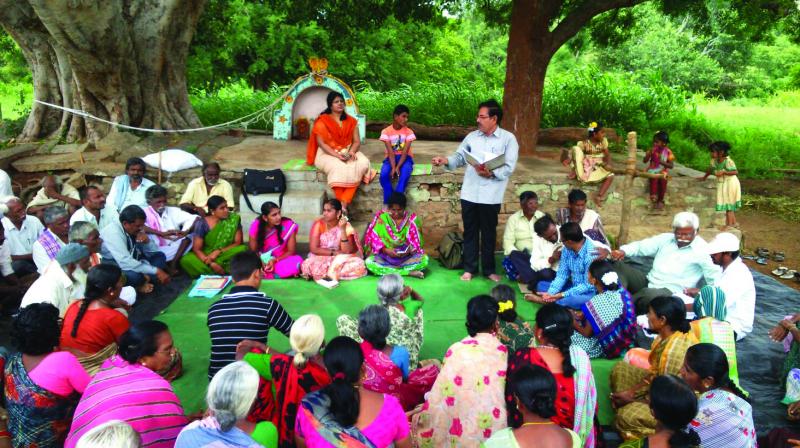Kerala: Decline and fall of grama sabhas
By turning their backs on grama sabhas, the educated class is allowing the corrupt and the non-deserving to thrive

THIRUVANANTHAPURAM: If the disgraced feudal system had 'untouchability', grassroots democracy, too, has developed its own reprehensible social norms. The most widely practised discrimination is the boycott of 'grama sabhas' by the state's educated upper- and middle-income groups. The state Planning Board, in an internal study, has found that the upper class, professionals and activists are turning increasingly indifferent to 'grama sabha' meetings. Development projects and beneficiary lists, as a result, are approved without any accountability. By turning their backs on how priorities are fixed and how the money is spent, the non-participants are allowing the corrupt and the non-deserving to thrive. But this has been the case ever since the heady first years of the People Plan movement that was launched in 1996.
"The high voltage People's Plan campaign had electrified people with the promise of radical changes and this had translated into huge attendance at grama sabha meetings. But the disillusionment set in surprisingly early," said Dr Jos Chathakulam, director of Centre for Rural Management. "Very soon grama sabhas deteriorated into places where those looking for personal favours from panchayats congregate," he added. As the state's tallest decentralisation expert Dr M A Oommen puts it: "Grama sabhas became associations of beneficiary seekers." Kerala Panchayati Raj Act, 1994, conceptualised the 'grama sabha' as the fourth-tier of governance, a further deepening of decentralisation from district, taluk and village levels. And these ward-level bodies were bestowed with powers of planning, decision making, implementation and monitoring of projects for local development.
"The primary duty of the 'grama sabha' is to express the felt needs of the people in the area and to define their priorities. With the educated staying away, grama sabhas have ceased to reflect the aspirations of the locality," Dr Oommen said. The Planning Board study echoes the sentiment. Here are some points it makes: grama sabhas have turned into an agency only for the selection of beneficiaries; working groups are not constituted; resource mobilisation is not taken seriously; development seminars are only in name; stakeholder consultations are mostly done away with.
"The psyche of the middle- and upper-class in the state is to confine themselves to their domain of activities," Dr Oommen said. According to Dr Chathakkulam, this social boycott of the grama sabha is "surprising". "The residents' association meetings are overcrowded, so are meetings of self help groups. Therefore it is not that they don't have opinions," Dr Chathakkulam said. "I think we need to create the right ambience at these meetings for the educated to feel comfortable," he said. M.S. Vasu, who as Kumily grama panchayat president had revolutionised grama sabha meetings, said that people should own the decision making process. "This can be easily ensured by hearing them, acknowledging their opinions and making the priority and beneficiary lists as transparent as possible," Mr Vasu said. According to him grama sabhas can be made vibrant if 'ayalkoottams' (neighbourhood groups) are rejuvenated.
"The projects recommended by the working groups are first discussed at the 'ayalkoottams'. The suggestions that are thrown up in the 10-12 'ayalkoottams' in a ward are then compiled by the 'ayalkoottam'convenors and chairmen and submitted before the grama sabha for a final round of discussion," Mr Vasu said. "Only such a process will make the people feel that they are heard and their opinions are respected," he added. But grama sabhas, instead of holding quality discussions on development programmes, invariably crack up into verbal duels between competing benefit seekers. "In such a situation even the few who had come out of genuine concern would leave, never to return," Dr Chathakkulam said. Yet, grama sabhas continue to be held without fail every three months. "There is likelihood that the participation of the people during a gram sabha meeting is managed, generated or even engineered to a certain extent," Dr Oommen said.
Perhaps the most intriguing aspect is the failure of political parties to encourage people to attend grama sabha meetings. "This seems like a big irony considering the massive efforts they undertake to reach people to the polling booth efforts they spend on bringing people to the polling booths," said Dr Jayalakshmy, a grassroots researcher. "Political parties should do something to address the odd mismatch between polling figures and grama sabha attendance," she added.
Voicing ward-level development plans
Grama sabhas, the fourth tier of decentralisation, should reflect the development aspirations at the ward level. The assembly of voters in each ward of a grama panchayat is called the grama sabha. Similar assemblies of urban local bodies (Municipalities and Corporations) are called Ward Sabhas. There are 20,500-plus wards in the state. Grama sabhas will have to meet at least once in three months at the place fixed by the grama panchayat, and to such meetings the convenor of the panchayat will have to compulsorily invite the members of the Block Panchayat, the District Panchayat and the Legislative Assembly representing the area of the grama sabha. Special grama sabhas can also be convened if a request is made in writing by not less than ten per cent of the members of a grama sabha.
The grama sabha will appoint, elect or constitute general or special sub-committees for detailed discussions on any issues or programmes and for the effective implementation of the schemes and the decisions. Such committees should have 10 or more members, and not less than half of them should be women. The priority list prepared by a grama panchayat after inviting applications for the selection of beneficiaries and conducting enquiries on the application received shall be scrutinised at the meeting of the sabha in which the applicants are also invited and a final list will be drawn up. This list will then be sent for the approval of the grama panchayat.

